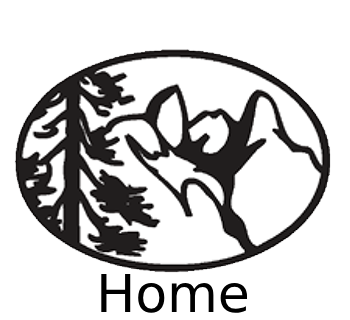
Southern Cypress Provincial Park’s easy access and diverse plant species make this area ideal for botanical studies. Plant lists for several areas within the park’s southern section have been compiled by Vancouver Natural History Society members and others.
Shrubs and Wildflowers
A wide range of subalpine shrubs can be seen along park trails, including:
Elliottia pyroliflora - Copperbush
(formerly Cladothamnus pyroliflorus)
Rhododendron albiflorum - White‑flowered rhododendron
R. groenlandicum - Labrador tea
R. menziesii - False azalea
(formerly Menziesia ferruginea)
Vaccinium sp. - Blueberry/huckleberry species, several
Spiraea densiflora - Subalpine spirea
Gaultheria humifusa - Alpine wintergreen
Kalmia microphylla - Western bog-laurel
Heathers (Phyllodoce and Cassiope sp) - Pink, yellow and white mountain‑heather
Arctostaphylos uva-ursi - Kinnikinnick, Common Bearberry
Wildflowers include:
Cornus canadensis - Bunchberry
Clintonia uniflora - Queen’s cup
Parnassia fimbriata - Fringed grass‑of‑Parnassus
Erigeron peregrinus - Subalpine fleabane
Arnica latifolia - Mountain arnica
Lupinus arcticus - Arctic lupine
Luetkea pectinata - Partridgefoot
Fauria crista-galli - Deer‑cabbage
Drosera rotundifolia - Round‑leaved sundew (a carnivorous plant)
Viola - four species of violets
Gentiana sceptrum - King gentian
Pterospora andromedea - pinedrops
Ferns, Grasses, Mosses, Liverworts, Lichens, Fungi
Ferns, mosses and other plants in these families may not be as noticeable at first, as brightly coloured wildflowers, but learning to identify them is a rewarding experience. A great number of different species can be seen at Cypress. Four species are described below:
Deer fern (Strythiopteris spicant, syn. Blechnum spicant):
These are commonly seen along the park’s moist forested trails as they need some moisture to survive. This evergreen fern is an important food for deer in some areas.Running clubmoss (Lycopodiella):
The bright green horizontal stems of running clubmoss can be seen creeping great distances along the ground in open areas. Their small stalked fruiting bodies stand upright like little trees or tuning forks.Narrow-leaved cotton-grass (Eriophorum):
This is a sedge (sedges have edges, feel the stems) which grows in wet meadows, dotting the landscape with white cotton-ball spikelets.Pipecleaner moss (Rhytidiopsis):
This yellow-green creeping moss forms large mats on the forest floor in subalpine old-growth forests.
The park is also home to a wide variety of fungi species. Many are mycorrhizal with trees. This is a relationship in which the trees supply carbohydrates to the fungi, and the fungi supply trace elements and water to the trees. Both groups benefit from this interaction. Many fungi thrive in the moist environment of the forests and others prefer the open meadows. Most species fruit in the damp weather of spring and fall.
Regionally Rare Plants at Cypress Provincial Park
The first three plants, listed below, have been seen only on the Pumphouse Road, which is perhaps warmer and more protected than other park areas.
Bog clubmoss:
Lycopodiella inundata (also known as Lycopodium inundata) can be seen occasionally in moist areas. Their vivid green colour is noticeable amongst orange sundews.Butterwort:
Pinguicula vulgaris used to be in the area now occupied by the snow-making reservoir which was created for the 2010 Olympics.Chamisso’s cotton-grass (Eriophorum chamissonis)
Seen only along Pumphouse Road just before the bridge leading up to Bowen Lookout. The fluffy pale-gold head is distinct from the white head of narrow-leaved cotton-grass.Copperbush (Elliottia pyroliflora)
Deer-cabbage (Fauria crista-galli)
Cypress is at the southern edge of range for this species.Fern-leaved goldthread (Coptis asplenifolia)
Cypress is at the southern edge of range for this species.Least moonwort [Blue-listed species] (Botrychium simplex)
Leathery grape-fern (Botrychium multifidum)
Three-leaved goldthread (Coptis trifolia)
Yellow mountain-heather (Phyllodoce glanduliflora)
Plant I.D. Books
Plant Lists to Download
Yew Lake Plant List (421kb):
Blue Gentian Lake Plant List (232kb):
Hollyburn 4-Lakes Loop Plant & Fungi List (354kb):
Black Mountain Plant List (261kb):
E-Flora BC is a biogeographic atlas of the vascular plants, bryophytes, lichens, algae, fungi and slime molds of British Columbia
Plants of Coastal British Columbia,
Pojar and MacKinnon, revised 2016.
Trees, Shrubs and Flowers to Know in British Columbia and Washington,
2nd edition, Lyons and Merilees, 1995. Lone Pine Publishing.
Click Here
Download article: "Domain of the Heathers" by Terry Taylor, Discovery 2003 (683kb)
iNaturalist
We encourage the general public to use the iNaturalist app to record what they see in parks, so you will be contributing to a citizen science generated database. Take a photo, upload it to the iNaturalist app, identify the species if you can or the app may be able to help. The app also relies on photo contributions to improve the identification ability of the app.
